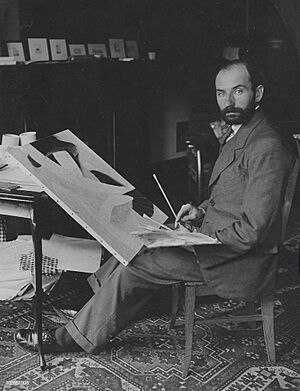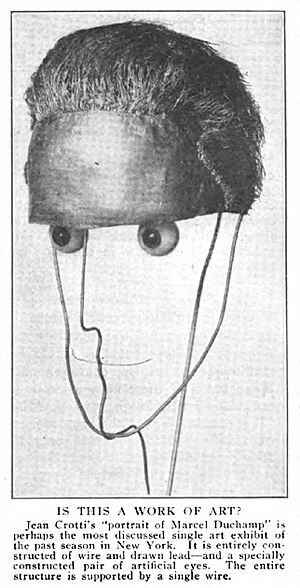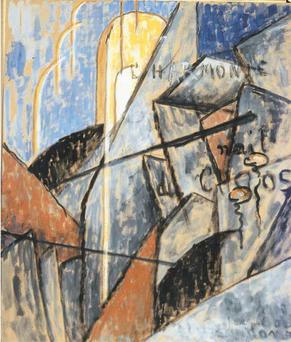Jean Crotti facts for kids
Jean Crotti (born April 24, 1878, died January 30, 1958) was a French painter. He was known for his unique and changing art styles. Crotti explored many different ways to create art throughout his life.
Contents
Early Life and Artistic Beginnings
Jean Crotti was born in Bulle, Fribourg, Switzerland. He started his art studies in Munich, Germany. He attended the School of Decorative Arts there. When he was 23, he moved to Paris, France. In Paris, he continued his art education at the Académie Julian.
At first, Crotti's art was influenced by Impressionism. This style uses small, thin brushstrokes to show light. Later, he was inspired by Fauvism, which used bright, bold colors. He also explored Art Nouveau, a style with flowing lines and natural shapes.
Around 1910, Crotti began to try out a new style called Orphism. This was a branch of Cubism. Orphism focused on bright colors and abstract shapes. His time in New York City helped him develop this style even more. There, he met famous artists like Marcel Duchamp and Francis Picabia.
Time in New York and the Dada Movement
During World War I, Jean Crotti moved to America. He saw New York as a place where he could grow as an artist. In New York, he shared a studio with Marcel Duchamp. He also met Marcel's sister, Suzanne Duchamp.
Suzanne Duchamp was part of the Dada art movement. Dada was a radical art movement. It challenged traditional ideas about art. Crotti soon became involved in this exciting new movement.
In 1916, Crotti showed his Orphist-like paintings. Some of these paintings had religious titles. He also created a Portrait of Marcel Duchamp. Another famous work was Les Forces MÈcaniques de l'amour Mouvement. He made this piece using everyday objects he found.
Return to Paris and Later Career
In the fall of 1916, Crotti went back to Paris. He later divorced his first wife. In 1919, he married Suzanne Duchamp. Suzanne was also a talented artist. She had a big impact on Crotti's painting style.
In 1920, Crotti created one of his most famous works. It was a portrait of Thomas Edison, the inventor. Crotti's art was shown in many important exhibitions. He participated in the 1925 Exposition International in Paris. He also showed his work at the International Exhibition of Modern Art. This exhibition was held at the Brooklyn Museum in 1926–1927.
Over the years, Jean Crotti created many paintings. He had several solo exhibitions. These shows took place in major art galleries. His work was displayed in England, France, Germany, and the United States.
Jean Crotti died in Paris on January 30, 1958.
Legacy and Collections
Jean Crotti's family later gave his personal papers to the Archives of American Art. This is part of the Smithsonian Institution. Researchers can look at these papers to learn more about his life and art.
In 2011, an art gallery called Francis M. Naumann Fine Art held an exhibition. It was called Inhabiting Abstraction. This show featured important works from all parts of Crotti's career. It included unique pieces like "Parterre de reve" (1920). For this work, he framed his painting palette and then signed it.





